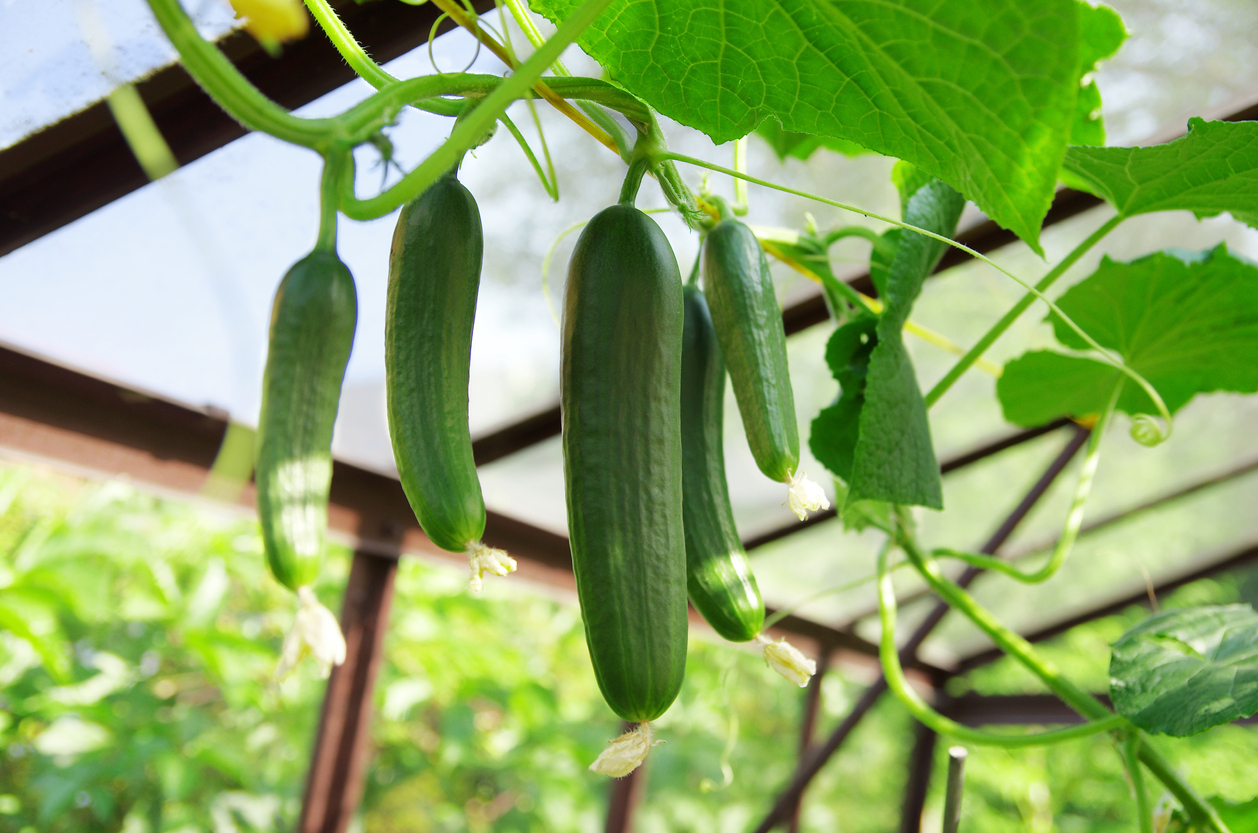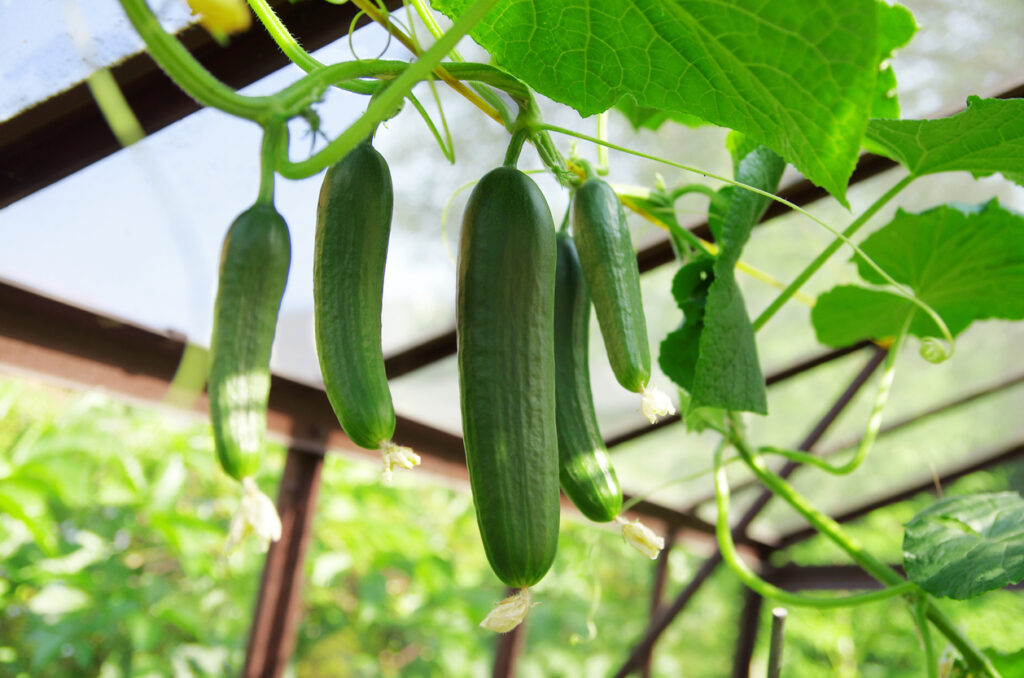Cucumber Care – How To Grow, Care For, And Harvest Cucumber
Pickled or sliced, raw, or in a green salad, the cucumber is a delicious vegetable that makes a memorable feast out of a simple meal. Just a short walk down the vegetable aisle tells you there are more than one type and variety of cucumbers. But you don’t have to go to the store to get the cucumber variety you like. You can just grow it in your garden and enjoy fresh and crunchy cucumbers all summer.
And did we mention that this veggie has great anti-inflammatory qualities that it has become a staple in many spas and beauty recipes? Whether you preserve it, cleanse your skin with its slices, or make a refreshing drink, the versatile cucumber has become synonymous with summer and its carefree days.
What is Cucumber?
The humble cucumber (Cucumis sativus) made its way to the New World on the Hispanola. It was Christopher Columbus who first introduced it to the people of Haiti. When the first settlers arrived, cucumber was already an established crop in America.
That’s good news for everyone thinking about growing cucumbers in their garden. No matter what weather conditions or type of soil you have, there’s always a variety of cucumber that can grow successfully in your neck of the woods.
It even benefits from having flowers and companion plants. So whatever you grow in your garden, cucumber plants will be a great addition to your veggie patch, flower bed, or rose garden.
The fruits vary depending on the type and variety of the plant you grow. For the most part, they are long, thick, and green. Harvesting and storing cucumber are some of the skills that every gardener needs to learn since it’s not always as simple and straightforward as it seems.
Types of Cucumber
Most of the plants we cover in this corner either have a type or a variety. But rarely would you come across a garden variety plant that has both a type and a cultivar. Well, as it happens, cucumber does have different types on top of having many varieties. So let’s acquaint ourselves with the different types first.
- Bush Cucumber: A compact plant that doesn’t exceed 36 inches on a good day. Its small size makes it ideal for containers. If you don’t have enough space for a large veggie batch, this type is the one for you. It has a fast growth rate and yields a decent crop every year.
- Vine Cucumber: This type needs a lot of space since it grows to about 6 feet tall and about 3 feet wide. This extra space translates into more crops as well. Unlike the bush type, vine cucumber is quite productive provided you grow it in the right conditions. As the name implies, these are creepers and will climb on a fence, border, or a trellis which gives them landscaping values on top of the juicy crop.
- Pickling Cucumber: Not all cucumbers are good for pickling. This type is distinguished by its smallish fruits with light green skin. They are often thinner than your average salad cucumber. The fruits all become ripe within a 10 day period. You need to harvest and pickle the cucumbers within that small window to get crunchy pickles.
- Slicing Cucumber: The fruits are often thicker and larger than the pickling types. They also have a larger window between developing the fruits and harvesting. They take about 6 weeks to fully mature which gives you enough time to harvest them at your leisure.
- Greenhouse Cucumber: This type is mainly for greenhouses. It requires very specific weather and humidity conditions. But the fruits are seedless so they are worth the trouble you go through to grow them.
- Lemon Cucumber: A unique type of cucumber with round or oval fruits. The yellow fruits are small in size and need to be harvested once they start to become yellow. If left on the plant, they grow seeds and become inedible.
- Cornichon: A French term that refers to small cucumbers meant for pickling.
Depending on the space limitations you have in your garden, you might want to stick to bush cucumbers since they don’t need a lot of space. You shouldn’t try to grow greenhouse cucumbers since they don’t do well outside of the protective confines of a greenhouse. As for lemon cucumber, it’s really an acquired taste and many people find it to be a hassle.
Cucumber Varieties
Now that you know which type to grow, it’s time to select the right cucumber variety. As we all know, popular plants tend to get the attention of agriculturalists who develop new hybrids and cultivars. Cucumbers are popular veggies and there are more cultivars than you care to grow in a single garden.
- Holland Hothouse: This is a vine cucumber that was developed mainly for greenhouses. However, it does well in the outdoors and has sweet fruits. You can grow it on a fence or a trellis for its bright green leaves as well as its crop. It takes a little over 2 months from the time you plant until the fruits are ready to harvest.
- Marketmore 97: A slicing cucumber that only takes about 55 days to bear mature crops. The fruits are sweet with a nice fresh flavor to them. The plants are disease-resistant and tolerate different types of soil.
- Cool Breeze: It belongs to the French small cucumber type known as cornichon. This variety has smooth skin, a sweet taste, and plenty of flavors. It only needs 45 days to grow and fruit. Don’t leave the fruits on the plant once they reach about 5 inches tall.
- Tyria: This cultivar is mostly for slicing. Its fruits have dark green skin and are sometimes ribbed. They average about 15 inches long which, by cucumber standards, is quite impressive. It takes about 56 days from the time you plant it until you can collect the ripe crop.
- Armenian: Another giant of a cucumber distinguished by its light green skin. It is usually curved unless you grow it on a trellis and harvest it before it reaches its full length. The longer it gets, the more curved it becomes. That along with the slightly acidic taste gave this variety the name “snake lemon”.
- Socrates: This cultivar takes only 52 days to yield its crop. The fruits are thin, light green, and have sweet and tender flesh. It can tolerate cooler climates and you can even grow it indoors if you prefer.
How to Grow Cucumber
The sheer number of cucumber types and varieties can make even the most experienced gardeners hesitate and scratch their heads in puzzlement. As you can imagine, the growing conditions for each variety may vary wildly. So it’s always recommended to check with the place you buy the seeds from for any special requirements for the variety you choose. Here, however, are the general steps that apply to growing most cucumber varieties.
- Select a sunny spot that gets plenty of afternoon sun. Cucumbers crave light and warmth.
- Till the soil before planting the seeds. Use a hoe to break the top 4 inches of the soil and mix in a generous portion of organic compost or manure.
- Dig a hole for each seed about one inch deep. You can plant the seeds in a row or in mounds. For vine cucumbers, it’s better to plant them near a trellis or a fence.
- Space the seeds about 3 feet apart for ground types. Vines need only one foot apart since they grow vertically.
- Water the soil enough to get it wet.
- Mulch the area around the seeds using chopped leaves or straw to maintain the moisture in the soil and prevent pests from stealing the seeds.
- Cover the rows or mounds with plastic to keep the soil warm in cool climates.
- When the seedlings are about 4 inches tall, you can thin them out and keep the healthy plants.
Cucumber Care
Cucumber is a heavy feeder. You’ll have your hands full with watering, fertilizing, keeping pests away, and finally harvesting. But as you’ll see, it’s totally worth every ounce of hard work you put into growing this delicious veggie.
Water
The watering needs of the cucumber grow as the plant starts flowering then develops fruits. That’s when you need to water it regularly and keep it hydrated. Otherwise, you risk having bitter-tasting crops that are not good for pickling, eating, or even as a face mask. Since they have a fast growth rate, you need to provide about 2 inches of water every week. Don’t wait for the soil to dry out between irrigations. Try to maintain a constant level of moisture in the soil especially in hot weather. But don’t overwater it. Root rot is a common problem with these sensitive veggies.
Soil
Sandy soil is usually the best type of soil for your cucumber. You can treat clay soil with compost, manure, or peat to improve drainage. The veggie also needs plenty of nutrition. So more organic matter in the soil means less fertilizing. Check the pH levels of the soil before planting and bring it either up or down to 6.0 or even 7.0. If you’re still worried about drainage, plant the seeds in mounds or raised beds.
Pests and Diseases
Unfortunately, as much as you enjoy a juicy and crunchy cucumber, pests tend to share that same appetite for this veggie. Some common pests you’ll have to fight off include aphids, cucumber beetles, squash bugs, and slugs. Of all of these bugs, the cucumber beetles are the most dangerous. The drill holes in the cucumber and damage your crop if you don’t intervene. You’ll need to pick them off and get rid of them along with slugs and squash bugs.
As for diseases, your cucumber can suffer from mosaic, scab, bacteria wilt, powdery mildew, and downy mildew. Most of these diseases are caused by insects so maintain a clean garden and remove debris regularly. You should also remove infected plants and dispose of them safely to prevent the spread of the disease.
Harvesting and Storing Cucumber
The best time to harvest your cucumber depends on what type or variety you grow. For the most part, your cucumbers are ready between 55 to 65 days from the time you plant them. Some varieties have a small window. If you miss it, they will lose their taste and flavors and grow seeds. If you want to increase your crop, harvest the mature fruits regularly to encourage the plant to grow more flowers and fruits. Almost all varieties are easy to pick by hand without the need for shears or scissors.
For pickling cucumbers, it’s better to start pickling them as soon as you pick them. This gives you juicy and crisp pickles. You can keep them in the jar for up to a year.
As for slicing cucumbers, you can store them in the fridge for up to 10 days before they start to lose their flavors. If you use chemical fertilizers to grow your cucumber, that shortens their storage time as well compared to ones fed with organic materials.

